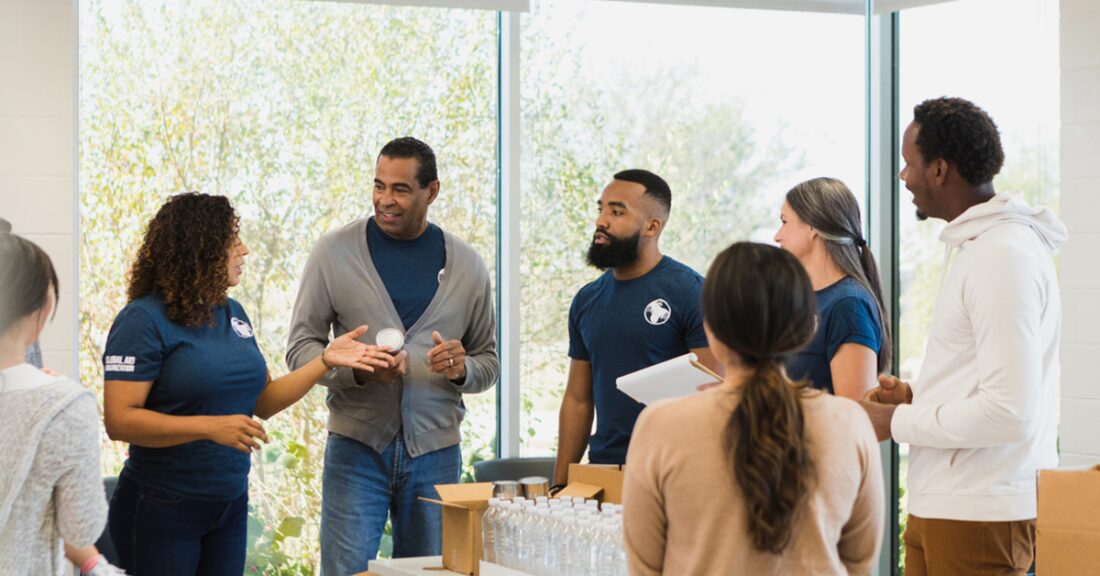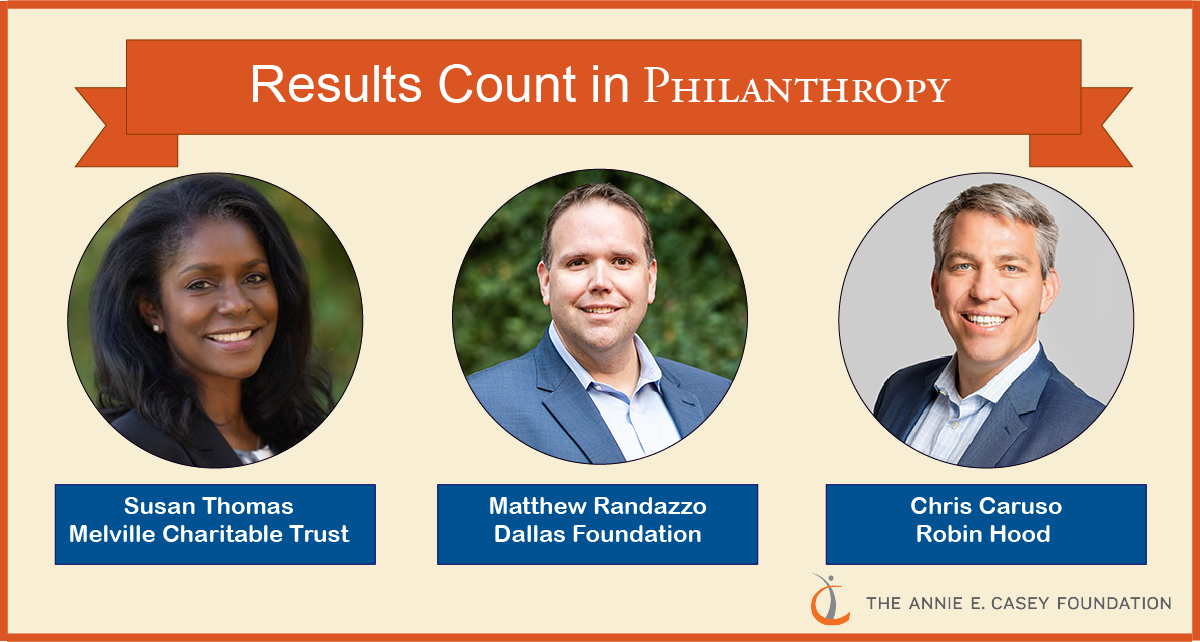Philanthropic Leaders Achieve Equitable Outcomes With Results Count

Leaders at the Melville Charitable Trust, Dallas Foundation and Robin Hood Foundation are using the skills and tools of Results Count® to improve the lives of children, youth, families and communities. Leveraging the Annie E. Casey Foundation’s approach to leadership development, these philanthropic executives are infusing their organizations with data-driven approaches to achieving equity. The leaders are alumni of Casey’s Children and Family Fellowship®, the Foundation’s signature Results Count program, which develops leaders’ confidence and competence to guide and sustain major system reforms and community change initiatives.

Susan Thomas, President, Melville Charitable Trust
A veteran of large-scale community change efforts, Susan Thomas joined the Melville Charitable Trust in 2014 and became its president in 2020. Under her leadership, the Connecticut-based foundation has broadened its investments in systems change, policy and advocacy to focus on the root causes of homelessness and unstable housing, in pursuit of measurable, equitable results.
Targeting the communities most affected by homelessness and housing instability, the Trust has defined a long-term population-level result: “All Black, Indigenous and Latino/a/x people with extremely low incomes will live in safe, stable, affordable housing in neighborhoods that allow them to thrive.”
The Trust used factor analysis, a Results Count tool, to identify the three root causes of homelessness and housing instability most impacting these populations:
- lack of equitable and rapid pathways to decent, permanent housing for people experiencing or at risk of homelessness;
- insufficient income and assets that create housing instability and expand the racial wealth gap; and
- discriminatory housing, zoning and land use policies that perpetuate housing instability and homelessness.
Aligned Action
The Trust developed its new framework in partnership with grantees and people working in the field. Through a series of roundtables, it also engaged people directly experiencing homelessness and housing instability to help reimagine its grantmaking. “These ‘Imagination Sessions’ were key to informing our strategy,” says Thomas. “The entire journey took a year, and we rolled out our new grantmaking framework in 2021.”
Learn more about Results Count
Partnering with others whose work is aligned with the Trust’s focus on racial equity is a key Results Count strategy it employed. “We collaborate with organizations that have a clear commitment to improving the lives of people who have been the most excluded from economic stability and wealth building,” says Thomas. “By partnering with others to address these root causes, we believe that over time we will see shifts in long-term outcomes.”
The Trust is working with its grantee partners to view their programs through a results lens. Although the Trust does not assist grantees in collecting data, it has designed a reporting structure that allows grantees to frame and present short‑, mid- and long-term measures of progress. An independent entity will survey the grantees to provide the Trust with frank feedback on what is, or is not, working with the new reporting emphasis.
Matthew Randazzo, President and CEO, Dallas Foundation
After a nearly 20-year career working to advance educational equity and improve college readiness for students of color and those from low socioeconomic backgrounds, Matthew Randazzo became president and CEO of the Dallas Foundation in May 2018.
Established in 1929, it was the first community foundation in Texas and is well-respected. And yet, until Randazzo’s arrival, the foundation did not have a clear framework for results or a focus on closing known equity gaps throughout Dallas County, whose population is approximately two-thirds people of color.
Closing Equity Gaps
At one of his first meetings with the foundation’s board, Randazzo made a presentation on a grantmaking fund of the foundation. Though its stated mission was to further the advancement of the Black community in Dallas, he noted that there had never been a Black person in a grantmaking role in the fund’s 30-year history. Moreover, he suggested a pause in this fund’s giving until the foundation appointed members of the local Black community to help oversee its grant activity. The board agreed.
Randazzo recalls that this board meeting “was really a galvanizing moment for us as an institution to say: ‘We must lean into equity, we must lean into a results orientation and we must be connected to the community in a way that community foundations should be but seldom are.’”
Working with consultants, the foundation identified 43 points in a Dallas resident’s life where some significant community inequity begins and persists. These points were concentrated in five broad areas:
- education;
- health;
- housing;
- criminal justice; and
- civic and voter participation.
Responding to the data, the foundation launched the Racial Equity Fund. Its purpose is closing equity gaps “from womb to tomb” for Black and Latino Dallas residents.
The internal result Randazzo and the foundation pursued “was somewhat simple,” he says. “Build a diverse institution that reflects the community we serve.” This goal has driven hiring decisions, promotions and appointments to the board. Today, 40% of the foundation’s board members are people of color, and more than half of the foundation’s 25 staff members are people of color.
Notable Results Count Concepts
One of the most meaningful Results Count concepts that Randazzo learned during his time as a Casey Children and Family Fellow was increased understanding of human behaviors in groups. “I think the group relations piece has been hugely important in terms of launching a rigorous change management process and holding steadfast to this idea of a shared result,” he says.
Another Results Count skill Randazzo has found helpful is using the process known as B/ART, which stands for Boundary of Authority, Role and Task. With B/ART, individuals and organizations can define their contribution to a result and what must be asked of others occupying different roles to achieve that result. As a philanthropic intermediary between donors and grantees, the Dallas Foundation is exercising its formal and informal authority to achieve results.
Chris Caruso, Managing Director for School-Age Children, Robin Hood
Chris Caruso joined Robin Hood in 2021 after serving as senior executive director of the New York City Department of Education’s Office of Community Schools. During that time, he worked with the Casey Foundation to build the capacity of his team to apply Results Count approaches, while leading the development of a citywide system of 300 community schools that integrated academics, health and social services for 150,000 students. According to independent research, these schools improved students’ academic and social outcomes.
After leaving city government, Caruso was drawn to Robin Hood because of its metrics-driven approach to grantmaking, which helps the organization better understand the effects of its investments. The foundation seeks to put New York City residents on a permanent pathway out of poverty, and Caruso’s overall goal is to significantly increase the number of students who graduate from high school and are prepared for college and a career.
Caruso’s grantmaking is grounded in the knowledge that students who graduate from high school and college will have significantly higher future earnings. Caruso is using the Results Count framework to break down some of the larger educational metrics. For example, research has shown that a high school diploma will boost future earnings by $8,000 per year. As part of this process, the foundation works with grantees to set measurable goals aligned with mobility milestones that are based on longitudinal data and predictive of future economic stability.
Reducing Disparities
A specific focus of Caruso’s grantmaking is decreasing educational disparities between Black and Latino students and their white and Asian counterparts. By disaggregating data, Robin Hood can see the effectiveness of its grants on both the entire population of students served and the racial subgroups facing the greatest barriers.
Caruso and his team are reversing the traditional philanthropic dynamic of potential grantees framing their work in terms of a foundation’s stated program goals. Instead, Robin Hood centers its grantmaking on the experiences and desired results of its community partners.
“They are closer to the ground, and they are working directly with schools and with kids and families,” says Caruso. “We are supporting their youth development and education efforts, with the basic understanding that their work is aligned with our goals.”
Central to these efforts is aligning the contributions of multiple partners. If a grantee works in a school, the foundation wants to know that its principal and staff are working toward a shared result. “We know that a successful grant or partner has to be aligned with other entities,” says Caruso.





